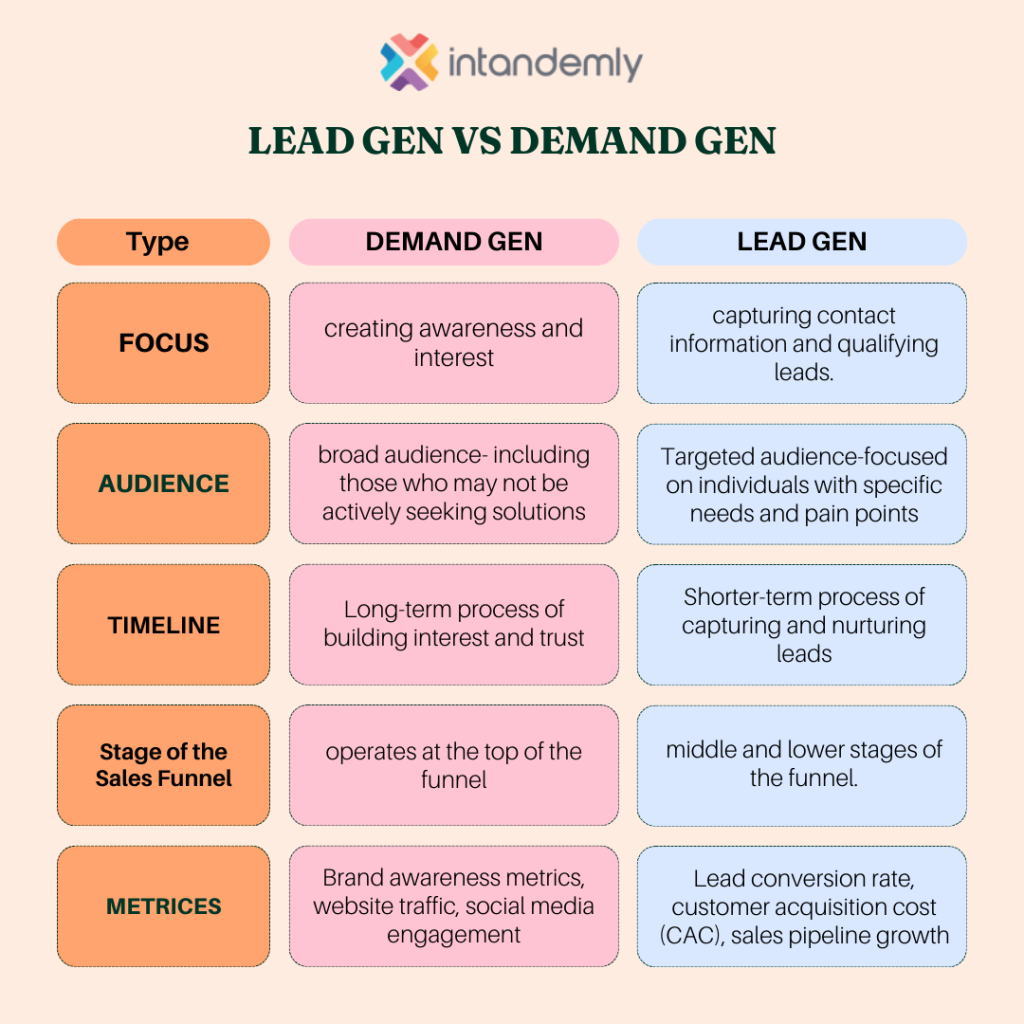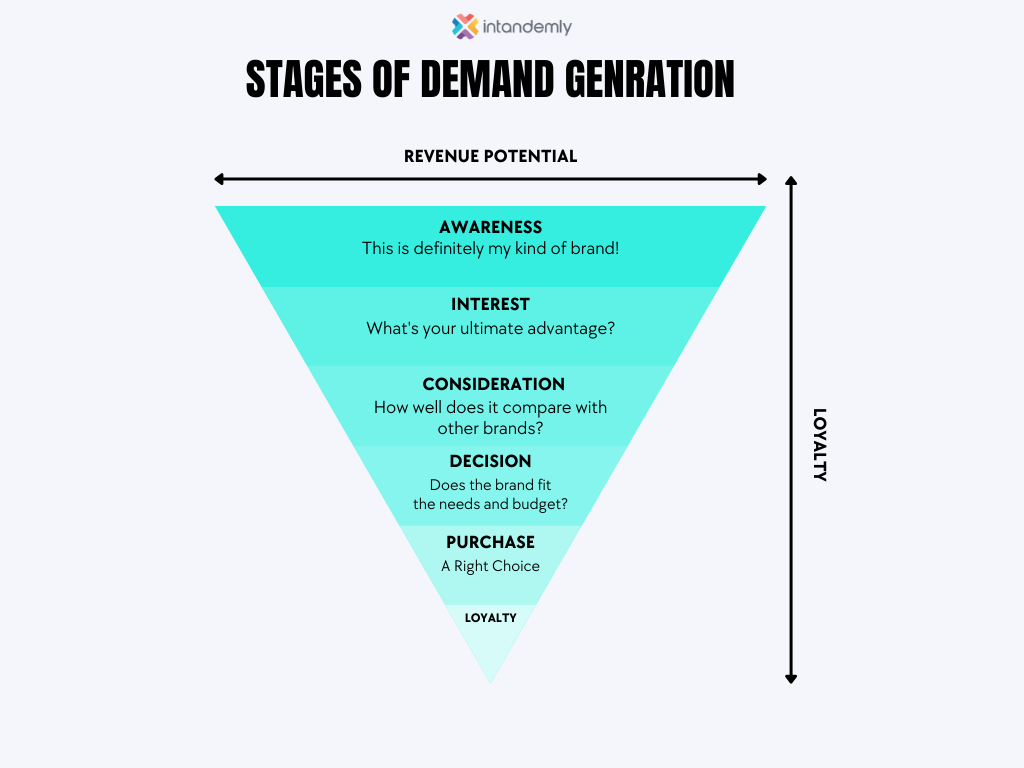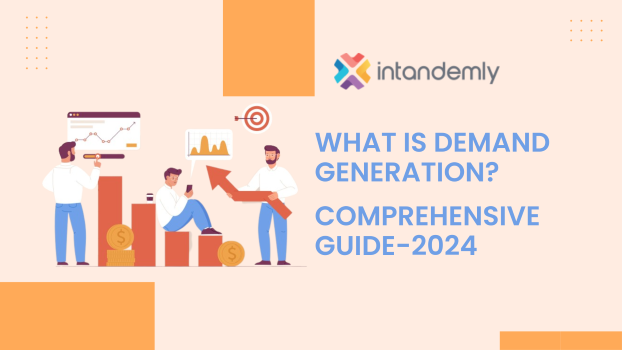What is Demand Generation ? FAQs-A Comprehensive Guide for 2024
INTRODUCTION:
Have you ever wondered how certain businesses seem to effortlessly attract a constant stream of customers, while others struggle to generate any interest at all? It's demand generation.
But what exactly is demand generation ? How does it differ from traditional lead generation? And most importantly, how can you leverage it effectively for your business's success? Whether you're a seasoned marketer or just starting out, understanding demand generation is crucial for driving growth and staying ahead in today's competitive market. So let's understand discover the power of demand generation together to take your business to new heights in 2024.
WHAT IS DEMAND GENERATION?
Demand generation is a marketing strategy that focuses on creating interest and demand in a company's products or services. It is the process of attracting and converting strangers and prospects into someone who has indicated interest in your company's product or service.
DEMAND GENRATION VS LEAD GENERATION
Marketing strategies play a pivotal role in attracting customers and driving sales. Among the various marketing tactics, demand generation and lead generation stand out as essential components for success. However, these terms are often used interchangeably, leading to confusion about their distinct purposes.

Scope and Purpose:
- Demand Generation: Encompasses a broader spectrum, focusing on creating awareness, interest, and demand for a product or service. It's about nurturing relationships and establishing brand presence.
- Lead Generation: Zooms in on identifying and collecting information about potential customers. The primary goal is to generate prospects who express interest in a specific offering.
Timeline and Engagement:
- Demand Generation: Takes a holistic, long-term approach, nurturing prospects from the initial stages of awareness through to the decision-making phase.
- Lead Generation: Often operates on a more immediate timeline, seeking to capture information and convert prospects into leads promptly.
Content and Strategy:
- Demand Generation: Leverages a variety of content types, from informative blog posts to engaging social media campaigns, aiming to educate and inspire the audience.
- Lead Generation: Focuses on content that prompts a direct response, such as downloadable guides, webinars, or free trials, with the goal of obtaining contact information.
Metrics and Measurement:
- Demand Generation: Metrics include brand reach, engagement, and overall market growth. Success is measured by the increased awareness and sustained interest in the brand.
- Lead Generation: Metrics revolve around the number and quality of leads generated. Conversion rates and lead qualification play a crucial role in assessing success.
Customer Relationship:
- Demand Generation: Aims to build and maintain relationships throughout the entire customer journey, creating brand advocates and loyal customers.
- Lead Generation: Primarily concerned with the initial stages of the customer journey, handing off leads to sales for further relationship building.
The Synergistic Power of Demand Generation and Lead Generation
While demand generation and lead generation serve distinct purposes, they work in tandem to fuel your sales pipeline. Demand generation creates the initial spark of interest, attracting potential customers, while lead generation captures their contact information and nurtures them towards a purchase decision.
An effective marketing strategy integrates both demand generation and lead generation efforts, ensuring a steady flow of qualified leads and driving business growth. By understanding their unique roles and working them in harmony, you can create a powerful marketing engine that attracts, engages, and converts potential customers into loyal patrons.
WHAT ARE BENEFITS OF DEMAND GENRATION?
Increased Brand Awareness and Recognition: Demand generation activities can help to raise awareness of your company's brand and products or services among potential customers. This can be done through a variety of channels, such as content marketing, social media marketing, and paid advertising.When people see your content, they are more likely to remember your brand andmore likely to consider your products or services when making a purchase decision.
Quality Leads:With the help of demand generation help to generate more quality leads for your business.This targeted approach ensures that your sales team focuses on qualified leads attracting people who are actually interested in what you have to offer.By creating valuable content and engaging with potential customers, you can attract more people to your website and capture their contact information. This information can then be used to nurture leads and move them through the sales funnel.This means that you will have more qualified leads to pass on to your sales team, which will lead to increased sales.increasing the likelihood of successful conversions.
Reduced customer acquisition costs: Demand generation helps to reduce customer acquisition costs by attracting more quality leads.This means that you will have a lower cost per lead, which will lead to increased profits.It involve cost-effective methods such as content marketing, email marketing, and social media engagement. By utilizing these channels, businesses can maximize their marketing investment and achieve a higher return on investment (ROI). A study by MarketingProfs found that companies that prioritize Demand Generation generate 50% more leads at a 30% lower cost.
Shortened sales cycles:Demand generation can also help to shorten your sales cycles by providing potential customers with the information they need to make a purchase decision. By educating leads about your products or services and addressing their concerns, you can make it easier for them to move forward with a purchase.
Increased customer lifetime value: Demand Generation fosters long-term relationships with potential customers by providing valuable information and building trust and hence increase the customer lifetime value (CLTV) of your existing customers. By keeping your customers engaged with your brand and providing them with valuable content, you can encourage them to make repeat purchases and become loyal customers.This nurturing process leads to increased customer loyalty and advocacy, promoting repeat business and positive word-of-mouth recommendations.
WHAT ARE THE STAGES OF DEMAND GENERATION?
Stage 1: Awareness
The first stage of demand generation is awareness. This stage is about making sure that potential customers are aware of your company and its products or services. You can do this through a variety of channels, such as content marketing, social media marketing, and paid advertising.
Stage 2: Interest
Once potential customers are aware of your company, you need to pique their interest and encourage them to learn more. You can do this by creating high-quality content that is relevant to their needs and pain points. You can also offer valuable lead magnets, such as e-books, white papers, and webinars, in exchange for contact information.
Stage 3: Consideration
The third stage of demand generation is consideration. This stage is about nurturing leads and moving them through the sales funnel. You can do this by providing them with more information about your products or services, addressing their concerns, and answering their questions.

Stage 4: Decision
The fourth stage of demand generation is decision. This stage is about helping potential customers make a purchase decision. You can do this by providing them with testimonials, case studies, and other forms of social proof. You can also offer free consultations or demos to help them try out your products or services.
Stage 5: Purchase:
Congratulations! All your efforts have converted the lead into a customer and it's time to onboard them with freebies and help them in smooth onboarding. This involves taking care of the customer to make them advocates.
Stage 6: Loyalty
The fifth stage of demand generation is loyalty. This stage is about building relationships with your customers and encouraging them to become repeat customers and brand advocates. You can do this by providing them with excellent customer service, offering loyalty programs, and creating opportunities for them to engage with your brand.
WHAT ARE THE BEST DEMAND GENERATION STRATEGIES?
Effective demand generation is crucial for the success of any B2B business. It involves attracting and converting potential customers into paying clients. While the specific strategies vary depending on industry, target audience, and budget, some general principles remain constant
1. Content Marketing: Crafting Value-Packed Narratives
Content marketing is a powerful and cost-effective way to attract and engage potential customers. By creating high-quality, informative content that addresses your target audience's pain points and interests, you can establish your brand as a thought leader and attract qualified leads.Effective content marketing encompasses a variety of formats, including blog posts, articles, infographics, videos, and case studies. Each format has its strengths and can be used to target different stages of the buyer's journey.
Interactive content, such as quizzes, polls, and interactive infographics, transforms the passive reader into an active participant. This immersive experience not only captures attention but also provides valuable data on user preferences and behaviors. Tailoring content to user responses enhances personalization, making the brand-customer interaction more dynamic and memorable.
2. Account-Based Marketing (ABM)
ABM focuses on identifying and targeting a specific set of high-value accounts, tailoring marketing efforts to the unique needs and decision-makers of each account. This targeted approach can yield significant returns for B2B businesses with a well-defined customer base.To implement ABM, you need to identify your target accounts and create a personalized marketing strategy for each one. You should also use data and analytics to track your results and make adjustments to your campaigns as needed.
3. Paid Advertising
PPC advertising allows you to reach potential customers directly when they are searching for products or services like yours. By carefully selecting keywords and crafting compelling ad copy, you can generate targeted traffic to your website and capture valuable leads.Platforms like Google Ads and social media channels enable businesses to target specific demographics, ensuring their message reaches the right eyes. Whether through display ads, sponsored content, or pay-per-click campaigns, paid advertising accelerates brand visibility, driving traffic and potential leads.
5.Chatbots
According to a study by Oracle, 82% of consumers say that they prefer using chatbots to resolve their customer service issues.Incorporating chatbots and live chat into your digital channels enables real-time engagement with prospects. This instant accessibility not only enhances customer experience but also allows businesses to qualify leads and provide immediate assistance.This can free up your sales team to focus on higher-value activities and improve the overall customer experience.
To use chatbots effectively, you need to train them to answer common questions and provide helpful information to your visitors. You should also monitor your chatbots' performance and make adjustments as needed.
6. Webinars and Virtual Events: Educate and Connect in Real Time
In an era where physical events face challenges, webinars and virtual events emerge as powerful demand generation tools. These live or on-demand sessions offer a platform to showcase expertise, interact with the audience, and generate leads. From product demos to industry insights, webinars foster engagement and position the brand as an authority in its domain.
Implementing a combination of these strategies, tailored to your target audience and industry nuances, can supercharge your demand generation efforts, creating a dynamic and effective approach to attracting and converting leads.
DEMAND GENERATION METRICES
Demand generation metrics are a set of key performance indicators (KPIs) that are used to track the success or failure of a demand generation program. These metrics help businesses to determine how effective their marketing efforts are at generating leads, nurturing relationships with potential customers, and ultimately driving sales.
Some of the most important demand generation metrics include:
- Marketing qualified leads (MQLs): MQLs are leads that have been identified as being qualified to be contacted by sales. MQLs are typically generated through marketing activities such as content marketing, email marketing, and social media marketing.
- Sales qualified leads (SQLs): SQLs are leads that have been further qualified by sales and are considered to be ready to be pursued for a purchase. SQLs are typically generated by nurturing MQLs through a series of personalized interactions.
- Website traffic: This metric tracks the number of visitors to your website. A high website traffic volume indicates that you are generating interest in your products or services.
- Cost per lead (CPL): CPL is the average cost of generating a lead. This metric is calculated by dividing the total cost of marketing activities by the number of leads generated.
- Cost per acquisition (CPA): CPA is the average cost of acquiring a new customer. This metric is calculated by dividing the total cost of marketing and sales activities by the number of new customers acquired.
- Lead-to-customer conversion rate: The lead-to-customer conversion rate is the percentage of leads that are converted into customers. This metric is calculated by dividing the number of customers acquired by the number of leads generated.
- Return on investment (ROI): ROI is the amount of revenue that is generated for every dollar that is invested in demand generation. This metric is calculated by dividing the total revenue generated from demand generation by the total cost of demand generation activities.
By tracking these metrics, businesses can get a clear picture of their demand generation performance. This information can then be used to make strategic decisions about how to allocate resources and improve the overall effectiveness of demand generation efforts.
DEMAND GENERATION SOFTWARES/TOOLS
Demand generation software and tools are essential for businesses that want to generate leads, nurture prospects, and close deals. These tools can help you automate many of the tasks involved in demand generation, such as email marketing, social media marketing, and lead scoring. They can also help you track your progress and measure your results.
HOW TO FIND THE RIGHT TOOL?
Finding the right software involves considering your specific needs and doing some research to compare available options. One way to start is by visiting software review websites like Software Suggest, Saas Worthy, G2 or TechImply. These platforms provide user reviews, ratings, and detailed information about various software solutions across different categories. You can filter and compare software based on features, pricing, and user feedback.
Additionally, exploring the official websites of software providers is crucial to understand the product in-depth, including its features, support, and any trial options available. Online forums and communities related to your industry or the type of software you're looking for can also offer valuable insights from real users. Remember to assess the scalability of the software to ensure it can grow with your needs. Always check for software compatibility, system requirements, and customer support responsiveness to make an informed decision tailored to your requirements.We are also listed and verified at all these platforms.

TIPS FOR BETTER DEMAND GENERATION
- Focus on quality over quantity. It's better to have a few high-quality leads than a large number of low-quality leads.
- Personalize your outreach. Take the time to learn about your leads and send them personalized messages.
- Be consistent. Don't just generate leads and then forget about them. Nurture them regularly with valuable content and offers.
- Use automation. There are a number of lead generation tools and software solutions that can help you automate your lead generation process. This can free up your time so that you can focus on other aspects of your business.
CONCLUSION:
And that's a wrap! We've had a detailed overviwe of demand generation including A to Z and answering the top questions or FAQs. Think of demand generation as your brand's superhero cape in the digital age. It's not just about getting people to notice you but making them genuinely interested and excited about what you offer.






![Content Marketing Trends-2024 [Comprehensive Guide]](https://www.intandemly.com/wp-content/uploads/2016/07/content-marketing-blog-banner-50x50.png)

